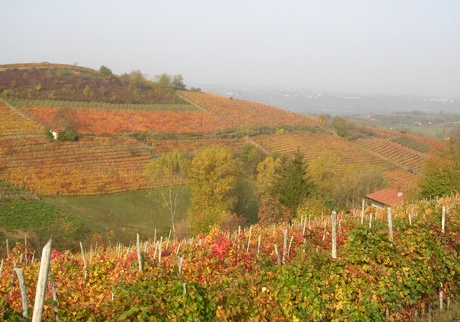
Name
Dolcetto of Langhe Monregalesi
Seal of quality
Guarantee of Origin.
A.O.C. – D.P.R. 6th July 1974
Description
The colour is that of a young wine, ruby with hues of violet; its bouquet is such as to attract the curiosity of the taster, with its fruity scents recalling cherries and jam; its flavour, dry and warm, completes its course with an almond aftertaste.
It is the result of the wine-making in pureness of the pure dolcetto vine and its minimum alcoholic content is 11% vol. Ageing is not foreseen, but if the wine presents an alcoholic content higher than 12% vol and is aged for at least one year, it can bear the qualification “superiore” on its label.
Area of production
The area of production corresponds with a region of 11 communes in the Langhe Monregalesi around Mondovì.
History
On the bordering hills between Cuneo and Liguria, Dolcetto is often called Ormeasco, and this arouses the thoughts, curiosity and imagination of many; some have even imagined – although there is no scientific confirmation of this – the sure relationship between Dolcetto and the Ormeasco vine that on the high grounds of Dolceacqua in Imperia gives origin to the wine of the same name.
However, we do know that between Liguria and Basso Piemonte there has been frequent contact and exchange of products ad farming equipment; therefore, there may well have been a precise connection between these two regions, also due to the Dolcetto species of vine.
The hills of the Monregalese – the city of Mondovì and another ten neighbouring towns – have been the homeland of Dolcetto for a long time and, in all probability, this presence has its meaning in the relationship between Liguria and Piedmont . Precise mention of the connections between Dolcetto and the Monregalese hills is made in documents that are treasured in the communal archives, and references can very easily be traced even in the place names that characterise parts of the region, and where perhaps there are no longer any vineyards whatsoever. F or example, the small hills namely “delle Vigne” in Roburent or “Pianvignale” in Frabosa.
Time, though, cooled all enthusiasm, leaving few vineyards on the Monregalese hills to remember the vines and the Dolcetto vine in particular.
Today, however, there seems to be a revival in this area, and the few wine producers left, like the last defenders of a sure tradition, are determined to bring back the splendour of this wine’s quality and appeal.
Thanks to the Aoc status acknowledged with DPR of 6 th July 1974, even Dolcetto delle Langhe Monregalesi now has its own small fortune to defend: the vineyards and actual production remain moderate with respect to other Dolcetto wines, but even small figures, if backed by authentic quality, are precious.
In 1994, the current “Consorzio di Tutela Barolo, Barbaresco, Alba Langhe and Roero” was founded as a point of reference for wine-producers in the area between Langa and Roero who have identified in this structure the most suitable means with which to face, together and with authority, problems relating to the development and organisation of their reality and sector as a whole.